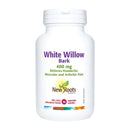New Roots White Willow Bark
White willow bark contains salicin, which is a monoglycoside of salicilic acid. This may sound familiar, as this plant is where the common pain reliever aspirin comes from.
The bark of this tree is known principally because of its properties to relieve pain and reduce fever. In the 19th century, a French chemist extracted the principal active ingredient of the willow and called it salicin. At the end of the 19th century, Felix Hoffmann, chemist for the Bayer company, produced the aspirin or acetylsalicilic acid. Nowadays, the tendency is to go back to the natural remedy to avoid the side effects of aspirin.
The willow 's bark contains glycosides; the most famous and active of them is salicin, which is a monoglycoside of salicilic acid. Salicilic acid is a soft anti-inflammatory agent, but it converts itself in acetylsalicilic acid in the body; this way, we get the most effective action of the ‚Äúaspirin,‚ but without the gastrointestinal toxicity.
Benefits:
- Used for inflammation and pain
- Treats fevers
| Supplement Facts | ||||
| Serving Size: 3 capsules | ||||
| Servings per Container: 50 | ||||
| Amount/Serving | ||||
| White willow bark (Salix alba) | 400 mg | |||
| Non-Medicinal Ingredients: Vegetable magnesium stearate in a non-GMO vegetable capsule composed of vegetable carbohydrate gum and purified water. | ||||
Take 3 capsules three times daily or as directed by your health-care practitioner.








